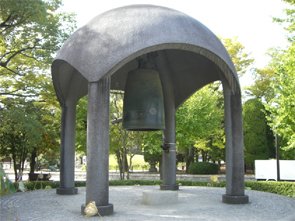
Date of completion
September 20, 1964
Established by
A-bomb Survivor Hiroshima Hope Fruition Society
Designer
Masahiko Katori
Shape
Bell: diameter of the opening − about 1m, height − 1.7m, weight − about 1.200kg
Belfry: a dome-shape roof representing the universe is supported by four pillars
Pond: width − 2m, depth − 80cm
Circumstances of the construction
This temple bell/temple hall is standing at the dearest wish of Hiroshima aiming at the creation of a world of a true peaceful coexistence without any nuclear weapons or wars, and was built as a symbol for this spiritual and cultural movement. We wish that the sound of the bell resound in each corner of the world and reach the hearts of each and every human being (on the erection on September 20, 1964, A-bomb Survivor Hiroshima Hope Fruition Society).
Noteworthy characteristics
- Bell
- Pond
- Japan's Soundscape − 100 Selected Sounds
The bell was made by bell-caster Masahiko Katori, holder of important intangible cultural assets (a living national treasure). On its surface a world map without national boundaries symbolising "one world" is embossed. The place where the log hits the bell shows the atomic energy symbol, expressing hope for the abolition of atomic and hydrogen bombs. On the opposite side is a mirror to reflect the heart of the person who rings the bell.
Lotus seeds were planted in the pond surrounding the belfry and every year around the date of the Peace Memorial Day on August 6th beautiful flowers bloom. After the bombing, lotus leaves were placed on people's wounds to reduce the pain of burns and console their spirits.
It was selected in 1996 for the Environment Agency's "One Hundred Sounds the Japanese People Wish to Preserve." (The selection includes the sounds in the park on August 6, including the ringing of the Peace Clock Tower bell, the Peace Bell, and the bell displayed in Peace Memorial Museum that is used in the Peace Memorial Ceremony.)